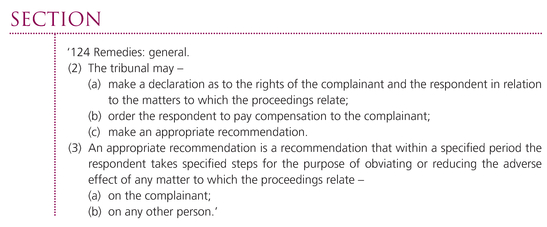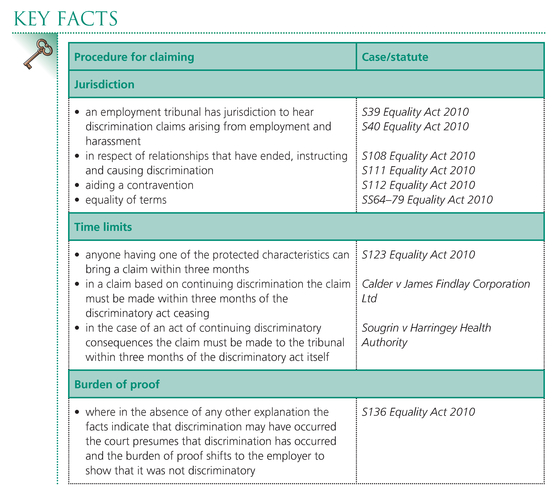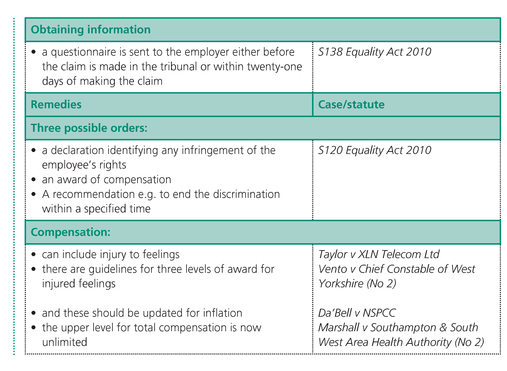15
Protection from discrimination (6) pursuing discrimination claims
Aims and Objectives
After reading this chapter you should be able to:
- ■ Understand the processes for submitting a claim
- ■ Understand the time limits, where the burden of proof lies and how information may be obtained
- ■ Understand the available remedies
- ■ Critically analyse the area
- ■ Apply the law to factual situations and reach conclusions
It is worth noting that it was identified in Lewisham & Guys Mental Health NHS Trust v Andrews (Deceased) [1999] IRLR 407 that a discrimination claim can survive the death of the claimant and be pursued by the personal representatives of the deceased under the Law Reform (Miscellaneous Provisions) Act 1934.
15.1 Procedure for claiming
Jurisdiction
An employment tribunal has jurisdiction to hear discrimination claims arising from employment under section 39 Equality Act 2010 as well as harassment under section 40, relationships that have ended under section 108, instructing and causing discrimination under section 111, aiding a contravention under section 112, and equality of terms under sections 64–79.
Time limits to making a claim
By virtue of section 123 Equality Act 2010 anyone having one of the protected characteristics identified in sections 4–12 and 18 of the Act can bring a complaint to an employment tribunal which must be within three months of the prohibited conduct about which they are complaining.
In this respect a distinction must be made between an act of continuing discrimination and an act with continuing discriminatory consequences. In a claim based on continuing discrimination the claim must be made within three months of the discriminatory act ceasing.

In the case of an act of continuing discriminatory consequences the claim must be made to the tribunal within three months of the discriminatory act itself. This can work against the employee where the act is a single act rather than a discriminatory policy for instance.

On the other hand there are circumstances in which the distinction could work to the benefit of the claimant.

Burden of proof
Section 136 Equality Act 2010 now identifies where the burden of proof lies in a discrimination claim in respect of any of the protected characteristics.
On this basis where the employee brings a claim of discrimination and in the absence of any other explanation the facts indicate that discrimination may have occurred the court will presume that the discrimination has occurred and so the burden of proof shifts to the employer to show that the act complained of was not discriminatory.
A claimant can also ask for details of statistics showing the numbers of people from a particular protected characteristic who have been appointed or promoted or dismissed or one of the other areas where discrimination may have occurred as this may be indicative of discrimination.
Questionnaire procedures and the obtaining of information
Section 138 Equality Act 2010 outlines the procedure for a claimant to obtain necessary information in respect of the claim. A questionnaire is sent to the employer either before the claim is made in the tribunal or within twenty-one days of making the claim.
The questionnaire is designed to help the person making the claim to find the reasons why the discrimination occurred. There are prescribed questionnaires for the different types of discrimination and the answers to the questions are admissible as evidence in the tribunal which can draw inferences from a failure to respond or from evasive answers.
Enforcement powers of the Equality and Human Rights Commission
The Commission has powers under the Equality Act 2006 (as amended) to bring proceedings on behalf of a person who has been discriminated against by direct discrimination under section 13 Equality Act 2010, disability discrimination under section 15 Equality Act 2010, gender reassignment discrimination under section 16 Equality Act 2010, pregnancy and maternity discrimination under section 18 Equality Act 2010, and indirect discrimination under section 19 Equality Act 2010. The proceedings must be commenced within six months of the conduct that is the subject of the complaint.
The Commission has powers to investigate and to issue notices to prevent repetition of the discrimination. It can apply to a court for an injunction to restrain a person from discriminating. It can provide a claimant with assistance in legal proceedings including financial assistance. It can also carry out formal investigations and issue nondiscrimination notices.
15.2 Remedies
If a tribunal has found that there has been a breach of one of the provisions identified in section 120, that is the work provisions in section 39, harassment under section 40, relationships that have ended under section 108, instructing and causing discrimination under section 111, and aiding a contravention under section 112, then the tribunal is able to grant one of the remedies outlined in section 124.
So in essence the section identifies three possible orders that the tribunal can make following a successful claim of unlawful discrimination:
- ■ A declaration of the infringement of the employee’s rights.
- ■ An award of compensation against the employer.
- ■ A recommendation to end the discrimination within a specified time (and if the recommendation is not complied with then this can result in an award of extra compensation).
A declaration of the infringement of the employee's rights
A declaration is relatively straightforward. It will identify whether an infringement of any of the rights under the Act have been infringed. It will also declare the rights of the employee and the employer in relation to the substance of the claim.
An award of compensation
An award of compensation in discrimination claims is on the tort scale as a result of which damages for injury to feelings is possible where some injury has been sustained and this is attributable to the discrimination.
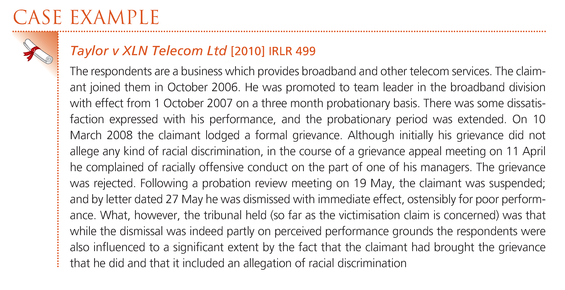
The claimant, a black employee, had issued a grievance and during the grievance procedure made a complaint of racial discrimination by one of his managers. He was then dismissed and the employer claimed that the dismissal was for poor performance. The claimant then suffered a psychiatric illness which he believed was a result of the dismissal. In his claim for unfair dismissal it emerged that while the dismissal was partly because of performance his employer was also influenced to a significant extent by the fact that he had brought the grievance and alleged racial discrimination which obviously amounts to victimisation. The tribunal had not made an award for injury to feelings or personal (psychiatric) injury because he was unaware at the time that it was attributable to the discrimination. The EAT held that this was irrelevant as the psychiatric injury was still attributable to the discrimination and that he should receive compensation for injury to feelings.
Courts have subsequently set guidelines as to how compensation for injury to feelings should be set.

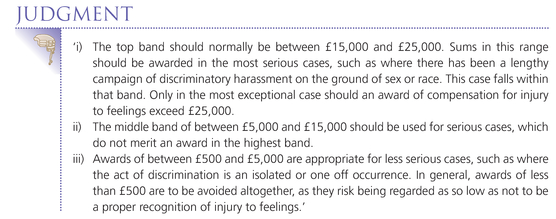
The case of Da’Bell v NSPCC [2010] IRLR 19 identified that the upper limits of the bands should be raised in line with inflation to £30,000, £18,000 and £6,000 respectively.
Traditionally awards were subject to the unfair dismissal maximum level. However, in Marshall v Southampton & South West Area Health Authority (No 2) [1993] IRLR 445 it was decided that there should be no upper limit. Now there is no upper limit and the award can include aggravated damages where the discriminatory treatment was malicious, insulting or oppressive. The award for injury to feelings is separate. There have subsequently been some very high levels of compensation awarded. In Ministry of Defence v Cannock [1994] IRLR 509 females serving in the armed services were forced to leave when they became pregnant. In their successful claim compensation of £300,000 was awarded.
If there has been indirect discrimination but the tribunal is satisfied that the practice, provision or criterion was not applied with the intention of discriminating then it must not make an award of compensation until it has considered whether to make a declaration or a recommendation.
A recommendation
The tribunal may issue a recommendation which is appropriate to the circumstances of the claim. The recommendation is likely to be that the employer takes specified steps to remove the discrimination within a specified period. It could also indicate improvements that the employer should make which could benefit other employees. If the employer fails to make the adjustments by the time set and has no reasonable excuse for not complying with the recommendation then the tribunal can make an order for additional compensation to be paid. There is no power to make a recommendation in the case of equal pay claims.
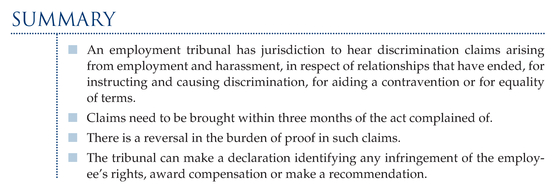
Further reading
Emir, Astra, Selwyn’s Law of Employment 17th edition. Oxford University Press, 2012, Chapter 4.
Pitt, Gwyneth, Cases and Materials on Employment Law 3rd edition. Pearson, 2008, Chapter 2.
Sargeant, Malcolm and Lewis, David, Employment Law 6th edition. Pearson, 2012, Chapter 5.4.


